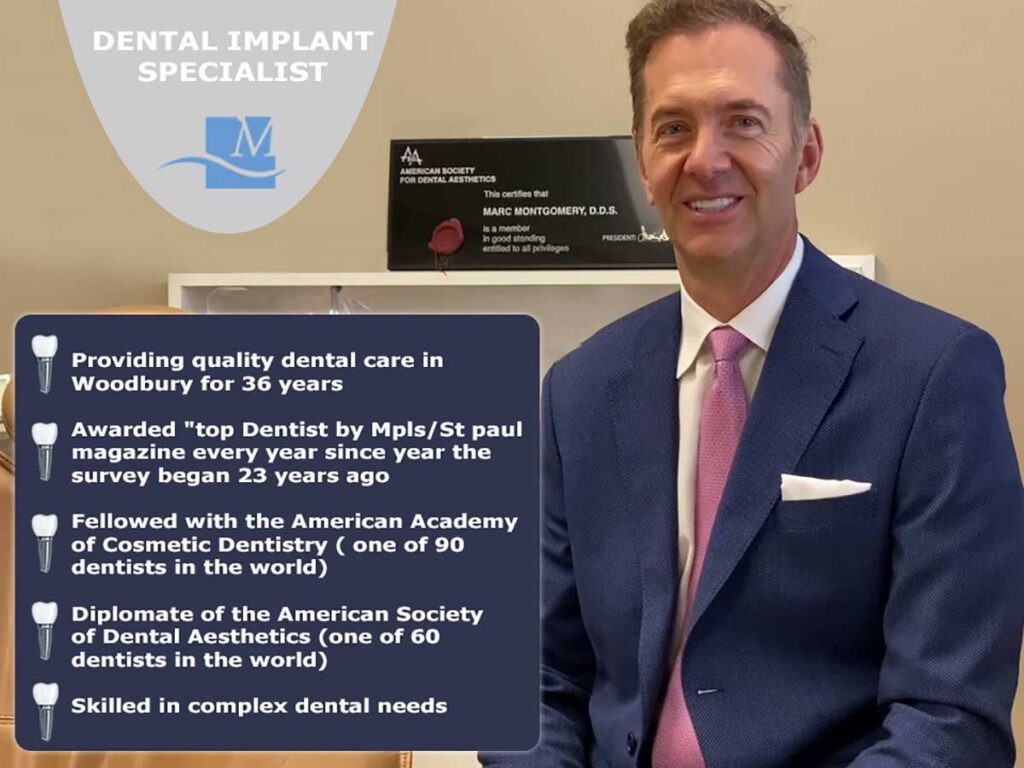Dental Implants
Monday: 7:30am – 5:00pm
Tuesday: 7:30am – 5:00pm
Wednesday: 7:30am – 5:00pm
Thursday: 7:30am – 5:00pm
Friday: Closed
Dental Implants: The Innovative Alternative to Bridges & Dentures

Dental implants have fast overtaken dental bridges as the best way to replace a missing tooth or teeth. At Montgomery Dental Care, Dr. Montgomery and his team have worked together for over 20 years perfecting implant dentistry. We never take shortcuts or use outdated and weak mini dental implants for our patients. Instead, we work with the top specialists in the Twin Cities to provide state-of-the-art implant dentistry using the latest techniques and titanium implants. We’ll coordinate all your implants needs for you to ensure you have a beautiful and natural-looking smile when you leave.
We transform people’s lives by perfecting smiles with guided digital implant planning and full arch restorations.
Schedule Your Appointment at
Our 5-Star Rated Dental Practice
What are the best dental implants?
We believe titanium is the best dental implant material today because it is biocompatible. Titanium is widely accepted as a safe metal to use in implantation. This means it is the best and most closely matched material to that of your natural teeth. It can also fuse with the human bone. This process is a system allowing for a customizable implant that solves low bone deficiencies. In the rare case that it is needed, most often it is a simple process to fix a loose dental implant.
Regular dental checkups after your implant surgery look for any frictional wear and ensure the long-term health of your implant.
What is the latest technology for dental implants?
Digital x-rays have advanced and revolutionized modern dental implant technology and placement. Computerized Tomography or CT scans make it quick and easy to expose x-rays during surgery to ensure proper implant placement. They let us see in-depth imaging that offers dental implant specialists far better detail than traditional dental x-rays. You may read up on the the advantages and possible disadvantages of oral implants.
Montgomery Dental Care is pleased to offer the latest in this dental technology. We are here to answer all of your questions in advance of any procedure. View our dental implants gallery to see our patients’ amazing results.
Requirements For A Successful Dental Implant
An article titled Implants in the Aesthetic Zone, written by Michael Sonick, DMD, talks about the requirements for implants to be functional:
- For an implant to be functional in addition to being aesthetically attractive, two criteria must be met: the implant body must be fully encased in bone and well-integrated, and the implant prosthesis must be as biomimetically shaped and positioned as possible. The integration process involves osseointegration.
- To perform a single anterior dental implant, a minimum of 2 mm of buccal bone needs to be present, as well as the minimum distance of 3 mm between it and any adjacent tooth. This is key for reducing recession and fostering papilla development respectively.
The Dental Implant Process
The process may be broken down into seven steps. However, this can be different for each person.
- It Starts with a Consultation: Your journey to gaining healthy dental implants begins with your initial consultation. Your implant specialist will evaluate your oral health desired goals, take CBCT scans, and discuss your medical history to assess if you’re an ideal candidate.
- Implant Treatment Plan: Insights from the evaluation will be discussed with you to agree on your personalized treatment plan. You will be apprised of the number of implants recommended, the type of restoration (crown, bridge, or denture) best for your scenario, and your appointment timeline.
- Implant Placement Procedure: Your initial surgical step entails placing the dental implant into your jawbone. Local anesthesia is provided as needed. A strategic incision in your gum tissue will expose the jawbone in preparation for inserting the implant screw. After it is in place, Your gum tissue is carefully closed. A temporary protective cover screw (also known as )healing abutment) will overlay the implant to protect it and support healing.
- Osseointegration: Now this critical process begins. During this time, your implant will fuse with your surrounding bone tissue, creating the right foundation for your future tooth crown. Osseointegration may take months. However, rest assured that you should be fine with a carefully customized temporary restoration in place.
- Dental Implant Abutment Placement: Upon completion of osseointegration and integration with your jawbone, a second minor surgery will place your abutment. Customized and prefabricated healing abutments on immediate implant sites function as a small connector that protrudes from the gum line and provides the attachment point for your dental crown.
- Implant Impressions: According to NCBI, dental implant impressions are taken between 8 and 12 weeks after implant placement and again four months later. The impressions are taken using a personalized impression tray and a pick-up impression coping. The impression captures the exact positioning of the implants and is then forwarded to a dental laboratory.
- Implant Crown Placement: This is an exciting step, as the implant placement restoration is driven to fulfill the patient’s goals. Placed onto the abutment, it is finished by placing the prepared crown. This is skillfully fitted for a perfect bite.
- Dental cement secures it: now you can enjoy your restored smile with improved functional occlusion and aesthetic appeal.
- Follow-up Implant Care: Your follow-up visits will be scheduled to ensure your implant’s success and healing. Your personal concerns or bite adjustment requests, if any, will be addressed at this time.
What is Osseointegration?
Osseointegration is the process when new bone growth occurs on the implant surface and the implant exhibits functional stability. It is the direct structural and functional connection between the living bone that holds your teeth and the surface of the implant custom made to fit in your tooth. Both the science and materials now available for tooth implant techniques have vastly improved.
The word osseointegration is derived from the Latin osseus, meaning “bony”, and integrare, meaning “to make whole”. The origin of the word does a good job of explaining its meaning.
What determines the successful outcome of a dental implant?
Correct dental form and function is core to the success of every dental implant. Montgomery Dental Care has many years of experience working even with more challenging cases. Whether your implant is needed in the maxillary anterior region, normal to high lip-line, thin biotype, for a scalloped gingival contour in a full mouth rehabilitation, we can manage your dental implant treatment.
We explain how our dental implant patients benefit from advanced CBCT technology in our Woodbury, MN office. We’re exciting to offer the best implant services possible today.
Your attention to personal oral care following dental implants is critical to a successful outcome.
How long does a typical dental implant process take?
The average implant patient can anticipate it taking several months to ensure the implant integrates properly with the jawbone. Nationally, cumulative reports indicate the process may take anywhere from five months to a year or more, depending on the individual case.
Study results published 12.08.2022 by the National Institutes of Health assessed 151 implants in 40 patients with a mean age of 56.43 ± 15.28 years at the time of implantation. Author Hongyang Ma reports in Long-term survival of implant-based oral rehabilitation that “The cumulative survival at 1-, 2- and 5-years was 96%, 87%, and 81%.”
This proves how successful dental implants typically are!
Call 651-738-1880 to make an appointment today!
Schedule Your Appointment at
Our 5-Star Rated Dental Practice
Look Flawless and Radiant Anywhere You Go!



